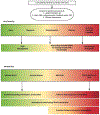Reducing the Global Burden of Alcohol-Associated Liver Disease: A Blueprint for Action
- PMID: 32986883
- PMCID: PMC9361217
- DOI: 10.1002/hep.31583
Reducing the Global Burden of Alcohol-Associated Liver Disease: A Blueprint for Action
Abstract
Alcohol-associated liver disease (ALD) is a major driver of global liver related morbidity and mortality. There are 2.4 billion drinkers (950 million heavy drinkers) and the lifetime prevalence of any alcohol use disorder (AUD) is 5.1%-8.6%. In 2017, global prevalence of alcohol-associated compensated and decompensated cirrhosis was 23.6 million and 2.5 million, respectively. Combined, alcohol-associated cirrhosis and liver cancer account for 1% of all deaths worldwide with this burden expected to increase. Solutions for this growing epidemic must be multi-faceted and focused on both population and patient-level interventions. Reductions in ALD-related morbidity and mortality require solutions that focus on early identification and intervention, reducing alcohol consumption at the population level (taxation, reduced availability and restricted promotion), and solutions tailored to local socioeconomic realities (unrecorded alcohol consumption, focused youth education). Simple screening tools and algorithms can be applied at the population level to identify alcohol misuse, diagnose ALD using non-invasive serum and imaging markers, and risk-stratify higher-risk ALD/AUD patients. Novel methods of healthcare delivery and platforms are needed (telehealth, outreach, use of non-healthcare providers, partnerships between primary and specialty care/tertiary hospitals) to proactively mitigate the global burden of ALD. An integrated approach that combines medical and AUD treatment is needed at the individual level to have the highest impact. Future needs include (1) improving quality of ALD data and standardizing care, (2) supporting innovative healthcare delivery platforms that can treat both ALD and AUD, (3) stronger and concerted advocacy by professional hepatology organizations, and (4) advancing implementation of digital interventions.
© 2020 by the American Association for the Study of Liver Diseases.
Conflict of interest statement
Figures




References
-
- Organization WH. Global Report on Alcohol and Related Conditions. 2018.
-
- World Health Organization. Global Status Report on Alcohol and Health. Geneva, Switzerland: World Health Organization.[cited in September 7, 2019]. Available in: http://www.who.int/substance_abuse/publications/global_alcohol_report/en/ 2018.
-
- American Psychiatric Association., American Psychiatric Association. DSM-5 Task Force. Diagnostic and statistical manual of mental disorders : DSM-5. 5th ed. Arlington, VA: American Psychiatric Association, 2013: xliv, 947 p.
Publication types
MeSH terms
Grants and funding
LinkOut - more resources
Full Text Sources
Other Literature Sources

